 The sound of the Gion Shoja bells echoes the impermanence of all things; the color of the sala flowers reveals the truth that the prosperous must decline. The proud do not endure, they are like a dream on a spring night; the mighty fall at last, they are as dust before the wind.
The sound of the Gion Shoja bells echoes the impermanence of all things; the color of the sala flowers reveals the truth that the prosperous must decline. The proud do not endure, they are like a dream on a spring night; the mighty fall at last, they are as dust before the wind.- Opening passage of the Heike Monogatari (13th century military romance. Translated by Helen Craig McCullough)
In the 18th century European romantic artists had a bit of a thing for ancient ruins. They represented decay and the notion that the accomplishments of man were transient and destined to ultimately be swallowed up by nature. I remember reading once that one Romantic painter (I forget who) was virulently opposed to the preservation of the ruins of Heidelberg castle in Germany. He found the process of their decay to be much more attractive than the actual ruins themselves. Thankfully saner heads prevailed and the ruins of Heidelberg castle were passed down to the present generation.
In Japan, as the above quoted portion of the Heiki Monogatari indicates, a similar fascination with the impermanence of life and human achievement has long permeated the nation's artistic and aesthetic traditions.
In its modern form this fascination manifests itself in the hobby referred to as "Haikyo", which roughly translates as "abandoned buildings". The combination of a declining population, urbanization (and the consequent de-population of rural areas) and economic stagnation over the past 20 years have created a vast number of abandoned ruins dotting the country and slowly being reclaimed by nature. Haikyo enthusiasts seek out, explore and photograph these ruins.
By "ruins" I should note that I don't mean ancient ruins, but the ruins of mostly 20th century buildings. Abandoned hotels and theme parks are all over the place here and their slow decay has a certain charm to it. The "mother" of all modern ruins is Gunkanshima ("battleship island") an island that once housed about 5,000 coal miners but was completely abandoned in the 1970s. Recent interest has led to efforts to have the island declared a UNESCO site. This guy here made a surreptitious visit to the island (its mostly off-limits due to the danger of the crumbling buildings) and posted his rather interesting story with some incredible pictures on his blog. I should probably stress that while that guy committed acts of trespass (which most Haikyo explorers do), I am more of a Haikyo "poser" and only photograph buildings from the street. I like looking at them but am not willing to break any laws to do so. I don't condone trespass but I have to admit, that guy's blog is really interesting.
As I've mentioned in earlier posts, Kyushu University's Hakozaki Campus, where I study, is currently in the long process of shutting down and moving to a newly-constructed campus on the Ito peninsula west of Fukuoka. This is part of a long plan which originated decades ago but has been plagued by all sorts of problems leading to huge delays. An archeological discovery at the site of the new campus required excavations that led to significant delays in construction. Then a million and one problems with the financing led to even more delays. I won't get into the details (I hear contradictory stories all the time about this and am not sure which is correct) but suffice it to say if things had gone as originally planned Hakozaki Campus would have been shut down and sold off years before I even arrived here. I'm thankful that things didn't go according to plan.
Despite the delays a number of departments have closed in recent years and made the move to Ito campus. As a result a large number of buildings on Hakozaki Campus now sit shuttered and abandoned. Today being a sunny Sunday and me being in an artistic mood I set out with my camera to record Hakozaki Campus's slow reversion to nature.
I entered through the Matsubara-Mon gate, which is on the opposite side of campus from where I have my office. I cycled down a dirt path to the left of the gate and came across an old tennis court:
 It was over-run with weeds and looked like nobody had played a set there in years. The clubhouse next to it looked like a frozen picture in time with some abandoned umbrellas and slippers scattered about while the vines grew all over the place:
It was over-run with weeds and looked like nobody had played a set there in years. The clubhouse next to it looked like a frozen picture in time with some abandoned umbrellas and slippers scattered about while the vines grew all over the place: Next to the clubhouse a fan rests in a pile of junk:
Next to the clubhouse a fan rests in a pile of junk: As does the court's old clock:
As does the court's old clock: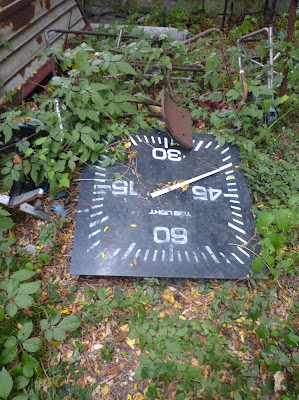 Next to the Tennis Court stand a number of abandoned buildings with corrugated metal siding that have been almost completely swallowed up by vegetation:
Next to the Tennis Court stand a number of abandoned buildings with corrugated metal siding that have been almost completely swallowed up by vegetation:
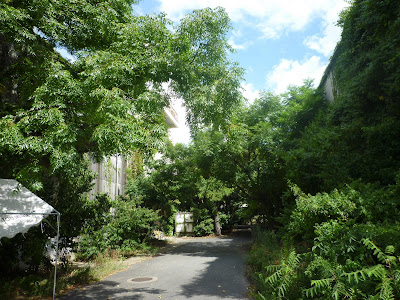
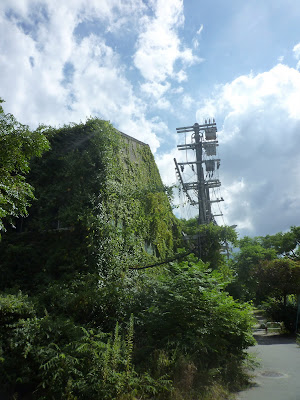 According to an old campus map I have (these buildings aren't identified on the new maps) high current electrical experiments used to be performed in them. I find it funny that now, years after they have been closed and been swallowed up by this greenery, these buildings are probably much more attractive than they ever were when in use.
According to an old campus map I have (these buildings aren't identified on the new maps) high current electrical experiments used to be performed in them. I find it funny that now, years after they have been closed and been swallowed up by this greenery, these buildings are probably much more attractive than they ever were when in use.Not all the abandoned buildings have been swallowed up like that though. This cute administrative building is boarded up and slowly decaying (bits of masonry have fallen off here and there) but the vines and weeds have been kept at bay:
 There is something painfully lonely about the sight of bulletin boards that have seen their last handbill:
There is something painfully lonely about the sight of bulletin boards that have seen their last handbill: The glass on this one is long gone. I tried to read the remnants of the handbills to find out how long they had been there but couldn't find any dates:
The glass on this one is long gone. I tried to read the remnants of the handbills to find out how long they had been there but couldn't find any dates: The area around the tennis courts near Matsubara-Mon have a lot of abandoned buildings on alleyways that are covered in greenery and kind of nice to explore. My next stop though was the absolute masterpiece of Hakozaki Campus's ruins: the old Chemistry and Engineering building:
The area around the tennis courts near Matsubara-Mon have a lot of abandoned buildings on alleyways that are covered in greenery and kind of nice to explore. My next stop though was the absolute masterpiece of Hakozaki Campus's ruins: the old Chemistry and Engineering building: This is actually a historically important building. It was built in 1925 and designed by a well-known architect named Kurada. Its one of the oldest concrete buildings in Fukuoka and was one of the most elegant buildings in town in its day. Even with years of neglect and the encroachment of nature the uniqueness of its design and its general attractiveness are still plainly visible.
This is actually a historically important building. It was built in 1925 and designed by a well-known architect named Kurada. Its one of the oldest concrete buildings in Fukuoka and was one of the most elegant buildings in town in its day. Even with years of neglect and the encroachment of nature the uniqueness of its design and its general attractiveness are still plainly visible.
 I'm not sure how long it has sat abandoned. I have a book about Fukuoka published in 1993 which has a picture of it and makes no mention of it being closed so it was likely still being used then. The size of this tree growing out of its foundation however suggests that it has likely been closed since not long after that, maybe since the late 90s:
I'm not sure how long it has sat abandoned. I have a book about Fukuoka published in 1993 which has a picture of it and makes no mention of it being closed so it was likely still being used then. The size of this tree growing out of its foundation however suggests that it has likely been closed since not long after that, maybe since the late 90s: The entrance to this stairway was probably one of the nicest in all of Kyushu back in 1925:
The entrance to this stairway was probably one of the nicest in all of Kyushu back in 1925: Its hard to even tell that there is a staircase here anymore:
Its hard to even tell that there is a staircase here anymore: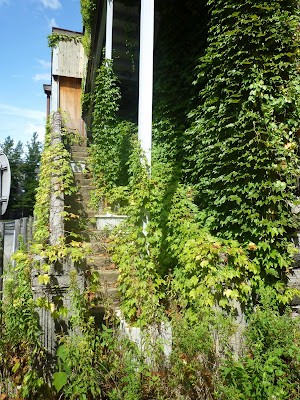 The west side of the building has a large chimney:
The west side of the building has a large chimney:
 This is the front of the building, it is the first site you see when entering the campus from the main gate. Once upon a time it would have offered a warm welcome to visitors but now....:
This is the front of the building, it is the first site you see when entering the campus from the main gate. Once upon a time it would have offered a warm welcome to visitors but now....:
 Moving on I head over towards the former site of the engineering faculty, which has alley after alley of abandoned buildings:
Moving on I head over towards the former site of the engineering faculty, which has alley after alley of abandoned buildings: This one is probably the most impressive, I think it might be pre-war as well judging from the architecture but could be mistaken:
This one is probably the most impressive, I think it might be pre-war as well judging from the architecture but could be mistaken:
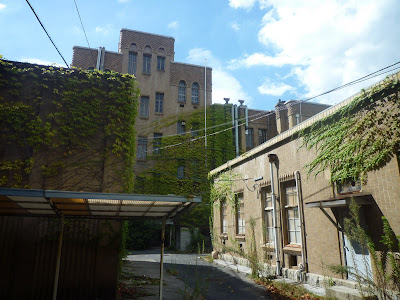 Some old signs sit with no one to read them:
Some old signs sit with no one to read them: Some of the buildings here weren't particularly attractive, designed in the "1960's era Soviet Block proletarian dreary" style:
Some of the buildings here weren't particularly attractive, designed in the "1960's era Soviet Block proletarian dreary" style: No bikes parked here anymore:
No bikes parked here anymore: I came across one of the "hidden gems" of Hakozaki here, this really nice red-brick building (red bricks are very rare in Japan):
I came across one of the "hidden gems" of Hakozaki here, this really nice red-brick building (red bricks are very rare in Japan):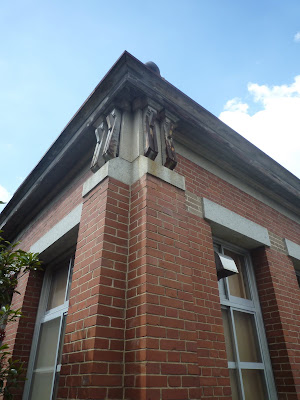 It had a nice old tiled roof:
It had a nice old tiled roof: And was quite long:
And was quite long: The real charm lay in the details though. Like this little pine tree growing out of the top of one of the columns:
The real charm lay in the details though. Like this little pine tree growing out of the top of one of the columns: The ornament that the pine tree had pushed out lay on the ground beneath, propped up against the side of the building:
The ornament that the pine tree had pushed out lay on the ground beneath, propped up against the side of the building: I also liked this window. Over the years different panes had been broken and replaced with new ones that didn't quite match the old:
I also liked this window. Over the years different panes had been broken and replaced with new ones that didn't quite match the old: After that I came to this mysterious building. It looked like a small shack of normal proportions at first:
After that I came to this mysterious building. It looked like a small shack of normal proportions at first: Yet closer inspection revealed it to be a capsule-shaped concrete cylinder, barely visible beneath the vegetation:
Yet closer inspection revealed it to be a capsule-shaped concrete cylinder, barely visible beneath the vegetation: Must have been used for some kind of experiments, but what kind I have no idea.
Must have been used for some kind of experiments, but what kind I have no idea.Nearby was this "signpost graveyard":
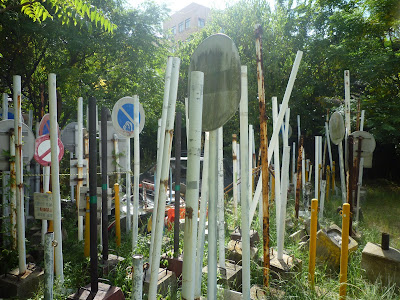 Doors that will never be opened again have a certain poignancy about them:
Doors that will never be opened again have a certain poignancy about them:

 My eye was next drawn to this tower looming in the distance:
My eye was next drawn to this tower looming in the distance: I made my way over to check it out, passing by some more smaller abandoned buildings along the way:
I made my way over to check it out, passing by some more smaller abandoned buildings along the way: The wood slats were falling off of this one:
The wood slats were falling off of this one: The building with the tower was (I believe, the signs had all been removed) formerly an aerospace engineering building:
The building with the tower was (I believe, the signs had all been removed) formerly an aerospace engineering building: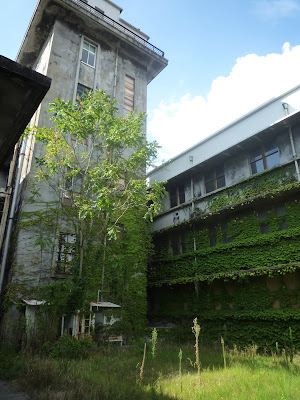 An abandoned tower has a certain charm to it, the way it looms over everything, the top part just barely tall enough to have avoided being swallowed up by the encroaching wildnerness:
An abandoned tower has a certain charm to it, the way it looms over everything, the top part just barely tall enough to have avoided being swallowed up by the encroaching wildnerness: Its interesting to think of what this courtyard would have looked like 30 years ago with tons of students milling about:
Its interesting to think of what this courtyard would have looked like 30 years ago with tons of students milling about: The vines are pretty thick on this one:
The vines are pretty thick on this one: The other side of the building was a bit less covered in them:
The other side of the building was a bit less covered in them: There was a long building with a corrugated roof that ran next to the courtyard:
There was a long building with a corrugated roof that ran next to the courtyard: Next stop on my tour was the agriculture faculty. The agriculture faculty hasn't moved yet so most of its buildings are still in use, except this one:
Next stop on my tour was the agriculture faculty. The agriculture faculty hasn't moved yet so most of its buildings are still in use, except this one: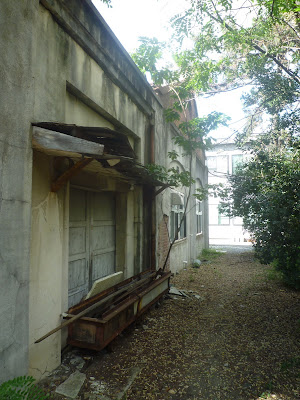 There was some sort of mini-train car in front of it, I have no idea what it was used for:
There was some sort of mini-train car in front of it, I have no idea what it was used for: I was kind of surprised to find that they have an abandoned tennis court also:
I was kind of surprised to find that they have an abandoned tennis court also: This isn't actually an abandoned thing, but I think these are kind of amusing. These are the emergency phones positioned around campus:
This isn't actually an abandoned thing, but I think these are kind of amusing. These are the emergency phones positioned around campus: Not exactly high-tech stuff, but I suppose they get the job done:
Not exactly high-tech stuff, but I suppose they get the job done: And that was the end of my exploration of Hakozaki Campus's ruins. Once proud and mighty buildings being reclaimed by mother nature, the sounds of students no longer echoing through their halls. They will never look the same again - next year their decomposition will be further advanced and the year after and so on until somebody either restores them or bulldozes them.
And that was the end of my exploration of Hakozaki Campus's ruins. Once proud and mighty buildings being reclaimed by mother nature, the sounds of students no longer echoing through their halls. They will never look the same again - next year their decomposition will be further advanced and the year after and so on until somebody either restores them or bulldozes them.The campus was pretty much deserted during my whole time there today, even the parts that weren't abandoned (its the summer holiday now). The only person I saw during my time in the abandoned part of campus was an old man with a crooked back carrying lots of shopping bags who looked like he might be homeless. When you are taking pictures of abandoned buildings you feel very conspicuous so I ignored him in the hope that he would ignore me. And he did, bustling off around a corner and disappearing as soon as he saw me. When you are taking pictures of major tourist attractions nobody blinks an eye but if you are taking pictures of something like a dirty old abandoned building, people may think you are up to something (what that something could be I have no idea, but at any rate it probably arouses a bit of suspicion). So I was glad that otherwise I had the place completely to myself.
I should point out here that at no point during my "tour" did I attempt to enter any of these buildings, which is what a lot of Haikyo enthusiast do. I just took pictures from the sidewalks or alleyways, which provided ample opportunity to get some good ones.
Related Posts:
- Hakozaki Campus's Wall of Mystery
- The Latter Days of an Idiosyncratic Library
- Kyushu University Hakozaki Campus